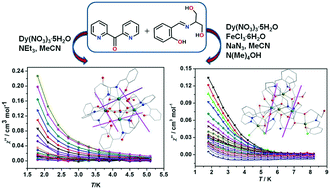Modulation of the directions of the anisotropic axes of DyIII ions through utilizing two kinds of organic ligands or replacing DyIII ions by FeIII ions†
Abstract
To modulate the molecular symmetry of tetrahedral Dy4 complexes, in this paper, we reported two complexes based on a Dy4 or Dy2Fe2 tetrahedral unit, namely, [Dy4(NO3)(HL)4{(py)2C(OH)O}2](OH)·6CH3CN·0.5H2O (1, H3L = 2-((2-hydroxybenzylidene)amino) propane-1,3-diol, (py)2C(OH)2 = the gem-diol form of di-2-pyridyl ketone) and [Fe4Dy2(μ4-O)(HL)3{(py)2CO2}{(py)2C(OH)O}{(py)2C(OCH3)O}(L′)Cl3]Cl·6CH3CN·3.5H2O (2, H2L′ = 2-amino-1,3-propanediol). In 1, each of the four sides of the Dy4 tetrahedron was constructed from one O atom of one (py)2C(OH)O− ligand and one O atom of one HL12− ligand, one side was constructed from two O atoms of two (py)2C(OH)O− ligands, and the remaining side was not constructed from organic ligands. Consequently, NO3− in 1 adopts an unprecedented η4, η1, η1, μ4 coordination mode, in which one O atom (O17) linked with four DyIII and each of another two O atoms further coordinated with a DyIII ion. For 2, the tetrahedral unit was composed of two DyIII ions and two FeIII ions, and each of the two DyIII ions is further linked with an FeIII ion. Slow relaxation behavior was observed for both complexes, with an energy barrier of 8.73 K for 1 under a zero dc field and 13.80 K for 2 under a 1500 Oe dc field, respectively. The orientations of the magnetic anisotropy of DyIII in 1 and 2 were calculated by the Magellan program, indicating that the easy magnetization axes of the four DyIII ions in 1 were not directed to O17, while the axes in 2 are nearly parallel to each other.



 Please wait while we load your content...
Please wait while we load your content...